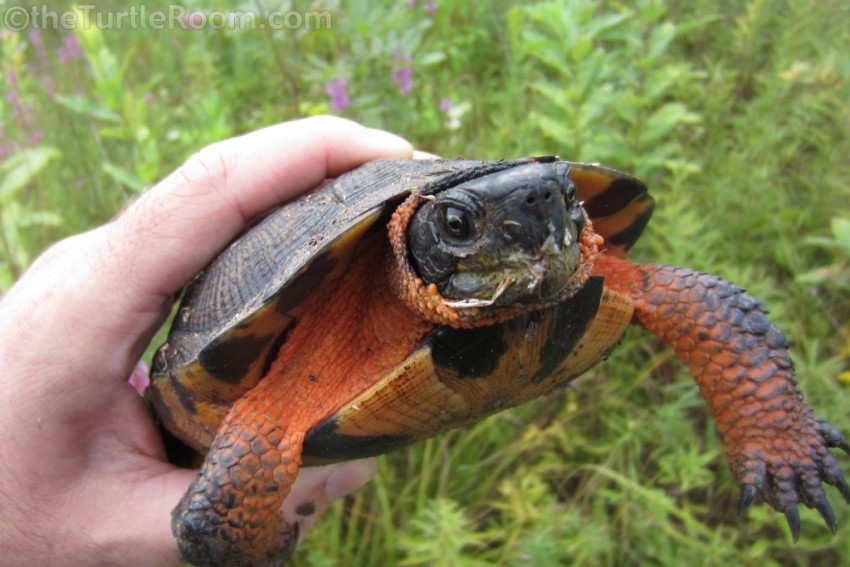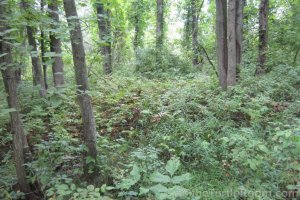Anthony heads out into the Adirondack Mountains of New York with Michael Musnick to track North American Wood Turtles.
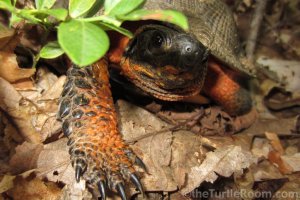 [dropcap]A[/dropcap]t a time when so many of our own race seem so occupied with the civilized world we have built for ourselves, one man has chosen to look past the skyscrapers and traffic-packed freeways that make up the cities like that in which he grew up. Citizen-scientist Michael Musnick spends much of his time on an important project for the state of New York. This distinction was not the type of gig that could have been found on indeed.com or monster.com – Musnick made this role for himself over time. His willingness to slow down and observe the natural world brought him to an important observation – North American Wood Turtles, Glyptemys insculpta, were living in areas he would frequent on his excursions outdoors.
[dropcap]A[/dropcap]t a time when so many of our own race seem so occupied with the civilized world we have built for ourselves, one man has chosen to look past the skyscrapers and traffic-packed freeways that make up the cities like that in which he grew up. Citizen-scientist Michael Musnick spends much of his time on an important project for the state of New York. This distinction was not the type of gig that could have been found on indeed.com or monster.com – Musnick made this role for himself over time. His willingness to slow down and observe the natural world brought him to an important observation – North American Wood Turtles, Glyptemys insculpta, were living in areas he would frequent on his excursions outdoors.
In years to follow, as often happens, the human population in the area grew and new construction plans developed rapidly. When news broke that one of Musnick’s most populated Wood Turtle habitats was to be developed, he brought his observations to town meetings. Biased individuals fought Musnick, citing that he had no right to be tracking the animals on lands that had become part of their own agenda, which led to his obtaining all legal state permits to continue conducting his research.
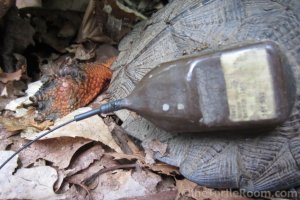 Today, more than 11 years later, Musnick has radio transmitters on approximately 60 North American Wood Turtles and a handful of Eastern Box Turtles, Terrepene carolina carolina, which are listed on the IUCN Red List as Endangered and Vulnerable, respectively. Transmitters cost roughly $140 each, and contributions he has worked hard to obtain from individual supporters have been imperative to his research. With his extensive tracking data, he aims to shed light on the manner in which these mysterious animals are using their specialized habitats. Hibernacula, basking, breeding, and nesting sites are all observed and recorded meticulously. Using radio transmitters, specific animals can be tracked, monitoring their movement, which can be compared to norms seen in the group. One thing that stands out is the varying usage of habitat from one individual to another. Specific animals have earned names due to their actions and relations to one another. As I asked Musnick about the specific names he mentions, I think of his obvious love for the animals he is tracking. We also discuss the fact that so much of the key research on specific chelonia has been conducted by graduate students, which all ends so quickly as those researchers graduate and move on to professional careers.
Today, more than 11 years later, Musnick has radio transmitters on approximately 60 North American Wood Turtles and a handful of Eastern Box Turtles, Terrepene carolina carolina, which are listed on the IUCN Red List as Endangered and Vulnerable, respectively. Transmitters cost roughly $140 each, and contributions he has worked hard to obtain from individual supporters have been imperative to his research. With his extensive tracking data, he aims to shed light on the manner in which these mysterious animals are using their specialized habitats. Hibernacula, basking, breeding, and nesting sites are all observed and recorded meticulously. Using radio transmitters, specific animals can be tracked, monitoring their movement, which can be compared to norms seen in the group. One thing that stands out is the varying usage of habitat from one individual to another. Specific animals have earned names due to their actions and relations to one another. As I asked Musnick about the specific names he mentions, I think of his obvious love for the animals he is tracking. We also discuss the fact that so much of the key research on specific chelonia has been conducted by graduate students, which all ends so quickly as those researchers graduate and move on to professional careers.
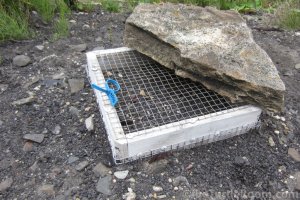 As we started our day, we walked along train tracks that run right past the first habitat we visited. Instead of heading towards the habitat, we walk the tracks, away from where the adult turtles are most often found. We headed in that direction to check on nests that had already been discovered, excavated, and then re-buried – now inside a wooden box with a hardware cloth cover. These boxes allow for the eggs to stay in the exact location the mother had chosen, but with security from predators. In past years, Musnick used a box with no bottom. The discovery of predation by shrews led to the current nest boxes, which are now secure on all 6 sides, including the bottom. No hatchlings were found the day I went out with him, but during our observations Musnick described the period every year, where he and others venture out every night for approximately 30 days straight, in hopes of finding nesting females whose nests can then be protected. He described watching a nesting female as an extremely exciting find, which can at the same time feel like watching paint dry, especially when they are merely digging test holes.
As we started our day, we walked along train tracks that run right past the first habitat we visited. Instead of heading towards the habitat, we walk the tracks, away from where the adult turtles are most often found. We headed in that direction to check on nests that had already been discovered, excavated, and then re-buried – now inside a wooden box with a hardware cloth cover. These boxes allow for the eggs to stay in the exact location the mother had chosen, but with security from predators. In past years, Musnick used a box with no bottom. The discovery of predation by shrews led to the current nest boxes, which are now secure on all 6 sides, including the bottom. No hatchlings were found the day I went out with him, but during our observations Musnick described the period every year, where he and others venture out every night for approximately 30 days straight, in hopes of finding nesting females whose nests can then be protected. He described watching a nesting female as an extremely exciting find, which can at the same time feel like watching paint dry, especially when they are merely digging test holes.
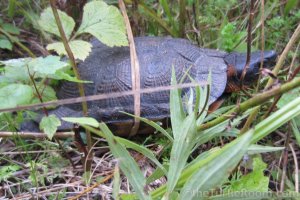 During our expedition, I couldn’t help but ponder my own herd of chelonians at home, and those under the care of keepers around the world. Both Wood and Eastern Box Turtles utilize a range that is vast, to say the very least. He has found that the range of male Wood Turtles, in particular, can be especially large. At one point, Michael and I ascended a mountainside, climbing over retaining rock walls, fallen trees and spider webs that seemed stronger than fishing line. I was just getting over being sick, so my energy level was a bit lower than I cared to admit, but I tried my best to keep up. As soon as we began conversing about how surprising it was that a North American Wood Turtle would come so high up this ridge, away from the water source below, we finally spot the turtle we were looking for. It was impressive just how large the home range for these turtles are. How can we justify keeping animals in such close-proximity to one another in captivity? Should we be surprised in those instances we see nipped toes and tails, aggressive face to face fluttering, or tortoises flipped onto their backs? So many thoughts rush through my head as we continue our search.
During our expedition, I couldn’t help but ponder my own herd of chelonians at home, and those under the care of keepers around the world. Both Wood and Eastern Box Turtles utilize a range that is vast, to say the very least. He has found that the range of male Wood Turtles, in particular, can be especially large. At one point, Michael and I ascended a mountainside, climbing over retaining rock walls, fallen trees and spider webs that seemed stronger than fishing line. I was just getting over being sick, so my energy level was a bit lower than I cared to admit, but I tried my best to keep up. As soon as we began conversing about how surprising it was that a North American Wood Turtle would come so high up this ridge, away from the water source below, we finally spot the turtle we were looking for. It was impressive just how large the home range for these turtles are. How can we justify keeping animals in such close-proximity to one another in captivity? Should we be surprised in those instances we see nipped toes and tails, aggressive face to face fluttering, or tortoises flipped onto their backs? So many thoughts rush through my head as we continue our search.
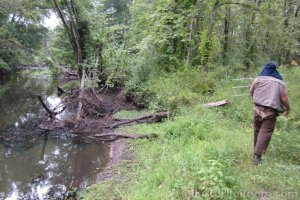 Mr. Musnick is in great shape and he has an impressive understanding of this land and the animals that call it home. He moves quickly through the brush, using a garden tool to snip thick overgrowth that has returned in the few days since he last visited this habitat. His clothing, tools and car are that of a dedicated outdoorsman, who has molded his life around these magnificent animals. Over the course of the day, we continued to move rapidly through each location and from one site to the next. At this point, he explained that throughout the land he surveys, habitat fragmentation and new development have negatively affected the population he tracks, saying, “We do lose a couple each year.” These words resonate with me, especially considering the time it takes for juveniles to reach adulthood, and the decades a breeding adult could stay in the population if it weren’t for the roadways they must now cross.
Mr. Musnick is in great shape and he has an impressive understanding of this land and the animals that call it home. He moves quickly through the brush, using a garden tool to snip thick overgrowth that has returned in the few days since he last visited this habitat. His clothing, tools and car are that of a dedicated outdoorsman, who has molded his life around these magnificent animals. Over the course of the day, we continued to move rapidly through each location and from one site to the next. At this point, he explained that throughout the land he surveys, habitat fragmentation and new development have negatively affected the population he tracks, saying, “We do lose a couple each year.” These words resonate with me, especially considering the time it takes for juveniles to reach adulthood, and the decades a breeding adult could stay in the population if it weren’t for the roadways they must now cross.
We spend an entire day searching. Thanks to his years of hard work and the numbers of turtles he has trackers on, we end the day having seen many turtles. As I reflect at the end of the day, I remember so many long hikes I have gone on, hoping to stumble upon a rare turtle. In my entire life as a turtle fanatic, I have not collectively seen in nature, the amount of endangered turtles as I have seen in this one day. I will be forever grateful for this opportunity, but also for the friendship and guidance I received from Mr. Musnick. The world is a good place, as long as there are people like him still living in it. I look forward to my next opportunity to join him in the field.
To see more pictures of Anthony’s day with Michael Musnick tracking Glyptemys insculpta, please visit the full photo gallery from the trip.


